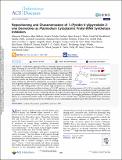Repositioning and Characterization of 1-(Pyridin-4-yl)pyrrolidin-2-one Derivatives as Plasmodium Cytoplasmic Prolyl-tRNA Synthetase Inhibitors
Author(s)
Okaniwa, Masanori; Shibata, Akira; Ochida, Atsuko; Akao, Yuichiro; White, Karen L; Shackleford, David M; Duffy, Sandra; Lucantoni, Leonardo; Dey, Sumanta; Striepen, Josefine; Yeo, Tomas; Mok, Sachel; Aguiar, Anna Caroline C; Sturm, Angelika; Crespo, Benigno; Sanz, Laura M; Churchyard, Alisje; Baum, Jake; Pereira, Dhelio B; Guido, Rafael VC; Dechering, Koen J; Wittlin, Sergio; Uhlemann, Anne-Catrin; Fidock, David A; Niles, Jacquin C; Avery, Vicky M; Charman, Susan A; Laleu, Benoît; ... Show more Show less
DownloadPublished version (1.591Mb)
Publisher with Creative Commons License
Publisher with Creative Commons License
Creative Commons Attribution
Terms of use
Metadata
Show full item recordAbstract
Prolyl-tRNA synthetase (PRS) is a clinically validated antimalarial target. Screening of a set of PRS ATP-site binders, initially designed for human indications, led to identification of 1-(pyridin-4-yl)pyrrolidin-2-one derivatives representing a novel antimalarial scaffold. Evidence designates cytoplasmic PRS as the drug target. The frontrunner 1 and its active enantiomer 1-S exhibited low-double-digit nanomolar activity against resistant Plasmodium falciparum (Pf) laboratory strains and development of liver schizonts. No cross-resistance with strains resistant to other known antimalarials was noted. In addition, a similar level of growth inhibition was observed against clinical field isolates of Pf and P. vivax. The slow killing profile and the relative high propensity to develop resistance in vitro (minimum inoculum resistance of 8 × 105 parasites at a selection pressure of 3 × IC50) constitute unfavorable features for treatment of malaria. However, potent blood stage and antischizontal activity are compelling for causal prophylaxis which does not require fast onset of action. Achieving sufficient on-target selectivity appears to be particularly challenging and should be the primary focus during the next steps of optimization of this chemical series. Encouraging preliminary off-target profile and oral efficacy in a humanized murine model of Pf malaria allowed us to conclude that 1-(pyridin-4-yl)pyrrolidin-2-one derivatives represent a promising starting point for the identification of novel antimalarial prophylactic agents that selectively target Plasmodium PRS.
Date issued
2021Department
Massachusetts Institute of Technology. Department of Biological EngineeringJournal
ACS Infectious Diseases
Publisher
American Chemical Society (ACS)